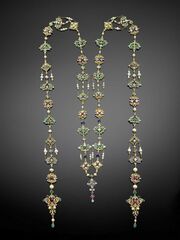Alexandrite
Description
A transparent, dichroic Gemstone that appears emerald green in daylight and dark red in artificial light. Alexandrite was named for Czar Alexander II, because the stone was discovered in the Ural Mountains in 1830 on his 12th birthday and because the red and green were the Imperial colors. It is a type of Chrysoberyl composed of beryllium aluminum oxide (BeAl2O4) with traces of Chromium. These natural stones are very rare and expensive. Outside of Russia, alexandrite stones have been discovered in Sri Lanka (about 1900), Brazil (Minas Gerais in 1987), Zimbabwe, Tanzania, and Myanmar. Synthetic alexandrite made from chrysoberyl may have a metallic luster and contain inclusions of flux. Artificial alexandrite stones made with synthetic Corundum (Sapphire) are red-violet in incandescent light and blue-violet in daylight.
Synonyms and Related Terms

chrysoberyl; alexandrite sapphire; alejandrita (Esp.); Alexandrit (Deut.)
Physical and Chemical Properties
- Orthorhombic crystal system.
- Good cleavage in one direction.
- Fracture = uneven to conchoidal.
- Luster = vitreous.
- Streak = colorless to white.
- Fluorescence = inert to moderate red under LW and SW
- Strong pleochroism with red, orange and green colors.
| Mohs Hardness | 8.5 |
|---|---|
| Density | 3.5-3.8 g/ml |
| Refractive Index | 1.745-1.754 |
| Birefringence | 0.008 to 0.010 |
Comparisons
Resources and Citations
- Gem Identification Lab Manual, Gemological Institute of America, 2016.
- Yasukazu Suwa, Gemstones: Quality and Value, Volume 1, Sekai Bunka Publishing Inc., Tokyo, 1999 Comment: RI=1.746-1.755; Specific gravity=3.73;
- Michael O'Donoghue and Louise Joyner, Identification of Gemstones, Butterworth-Heinemann, Oxford, 2003 Comment: RI=1.74-1.75; Specific gravity=3.71; DR=10.008-0.010;
- Encyclopedia Britannica, http://www.britannica.com Comment: "chrysoberyl" [Accessed May 8, 2003].
- Jack Odgen, Jewellery of the Ancient World, Rizzoli International Publications Inc., New York City, 1982
- R.F.Symmes, T.T.Harding, Paul Taylor, Rocks, Fossils and Gems, DK Publishing, Inc., New York City, 1997
